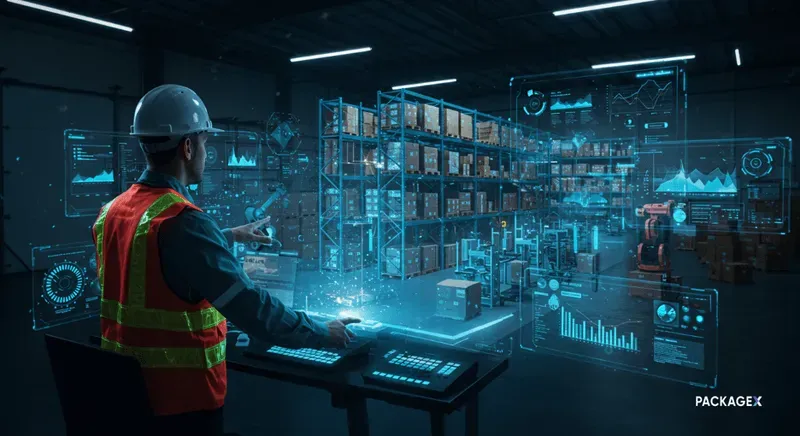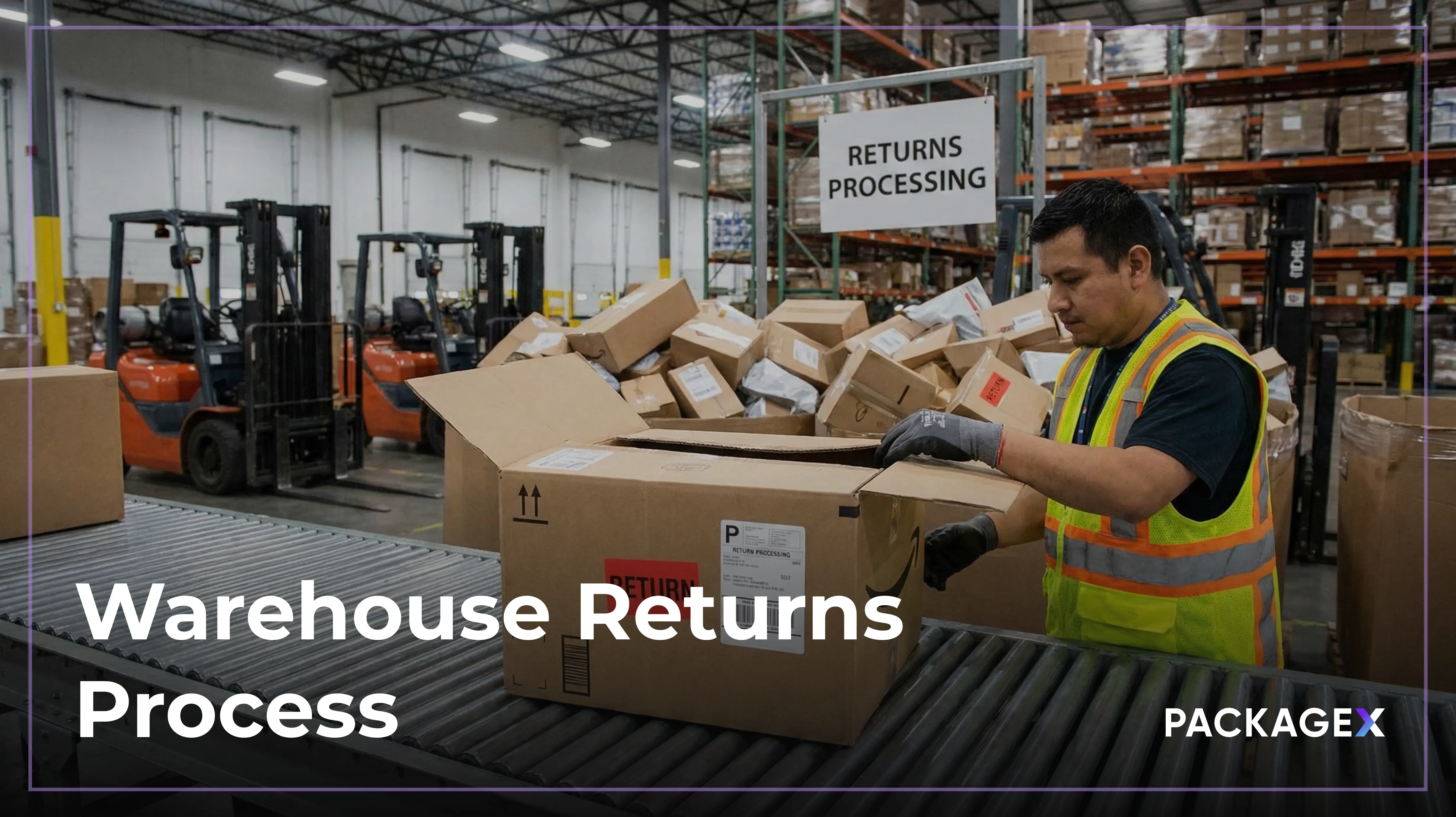Remember when Samsung had workers sleeping in tents inside their Vietnam factories during 2024?
Workers complained for two days. Then, they were moved onto the factory's premises. The lines between their workplace and home evaporated. For nearly three weeks, Nam slept with a blanket on a mattress in a warehouse alongside around 100 other male colleagues. That's what happens when your warehouse management falls apart during a crisis.
Electronics companies face a unique challenge. Your products are small, valuable, and come in thousands of variations. One mix-up costs more than most companies make in a month. Yet many electronics warehouses still run like it's 1995.
Things are changing fast. Industry analysts are tracking massive growth in electronics components - we're looking at a jump from $186.38 billion in 2022 to potentially $328.5 billion by 2031. What does this mean for you? More parts to track, more suppliers to manage, and way more opportunities for costly errors.
Here's what most people don't tell you about electronics warehouse management. It's not just about tracking boxes. It's about surviving in an industry where a single component shortage can shut down your entire production line.
The Real Problem with Traditional WMS in Electronics
Tesla learned this the hard way. Tesla was hoping to produce 5,000 new Model 3 electric cars each week in 2018. So far, it has failed to manufacture even half that number. Questioned on the matter, the company's CEO, Elon Musk, claimed that "excessive automation was a mistake" and that "humans are underrated".
Electronics companies make the same mistake over and over. They think more technology automatically means better results. But here's what actually happens.
Traditional warehouse systems were built for simple products. Think t-shirts or boxes of cereal. Electronics are different. You might have 50,000 different components, each with different storage requirements, shelf lives, and handling procedures.
Your current system probably can't tell the difference between a $2 resistor and a $200 processor chip. It handles them exactly the same. It's like trying to fix a Swiss watch with a sledgehammer.
Why Electronics Warehouses Are Different
Take a walk through any electronics warehouse during peak hours. You'll notice the constant scrambling. Companies are desperately hunting for new suppliers and trying alternative materials just to keep operations running. Meanwhile, they're struggling to hire back skilled workers who jumped ship to other industries during the disruption years.
Your warehouse deals with products that:
- Come in thousands of tiny variations
- Have strict temperature and humidity requirements
- Expire or become obsolete quickly
- Cost hundreds of dollars per cubic inch
- Need anti-static handling procedures
Most warehouse management systems were designed for furniture stores, not electronics manufacturers. They can't handle your complexity.
The Hidden Costs You're Already Paying
With high inflation, rising interest rates, the threat of recession, and ongoing trade disputes, the operating environment for the electronic components industry remains challenging heading into 2024.
While you're worried about market conditions, your warehouse is bleeding money in ways you might not notice:
Component Obsolescence: Electronics become outdated fast. Your current system probably can't track which components are approaching obsolescence or automatically flag slow-moving inventory. Result? You're sitting on millions of dollars of worthless stock.
ESD Damage: One static shock can destroy an entire batch of sensitive components. Traditional systems don't track environmental conditions or ensure proper anti-static procedures. You're replacing damaged inventory without knowing why.
Mix-ups: Samsung and Apple learned this lesson expensively. Between them, the two companies have dominated the manufacturing of smartphones since the early 2010s, and made about 40% of all smartphones sold worldwide as of 2024. By late 2011, Apple and Samsung were litigating about twenty cases in ten countries. Much of their conflict stemmed from global supply chain issues and component sourcing problems.
Labor Inefficiency: High inventory turnover rates present a significant challenge in warehouse management. Many warehouses experience frequent employee departures. The warehouse labor market survey revealed that 40% of operators reported improved staffing conditions, yet turnover remains an issue.
Your workers spend more time looking for parts than picking them. With electronics components, finding the right part among thousands of similar-looking items wastes hours every day.
How Modern WMS Actually Works for Electronics
The best electronics companies figured this out during the supply chain chaos of 2024. Tesla also had to suspend some of its European production in January after attacks on ships in the Red Sea led to a shortage of components. When disruption hit, companies with smart warehouse systems kept running while others shut down.
Modern warehouse management for electronics works differently. Instead of treating everything like generic boxes, it actually knows what you're storing.
Your system starts recognizing which components need refrigeration, which ones go bad first, and which suppliers always deliver late. It doesn't just count things - it tracks condition, age, and whether parts work together.
Your warehouse becomes constantly aware of its environment. Sensors watch humidity, temperature, and static electricity around the clock. When conditions start drifting toward danger zones, you get warnings before anything gets damaged.
Workers stop wandering around looking for parts. The system maps the smartest routes based on what they're carrying - heavy transformers don't get mixed with delicate sensors. Damage drops, speed goes up.
Behind the scenes, algorithms crunch through your usage patterns. They spot trends you'd never notice and predict shortages weeks before they happen. The system considers everything - seasonal rushes, supplier hiccups, even how long different components typically last.
Real Implementation That Works
Here's how to actually implement warehouse management that works for electronics companies. Not theory. Real steps that work.
Week 1-2: Map Your Real Workflow
Don't start with the software. Start with your actual problems.
Walk your warehouse floor during your busiest time. Count how many times workers touch each component. Time how long it takes to find specific parts. Document where mistakes happen most often.
Most electronics companies discover they're handling components 3-5 times more than necessary. Each touch increases damage risk and slows down operations.
Clean Your Data First: Electronics components have complex part numbers, manufacturer codes, and specifications. Your data is probably a mess. Fix this first.
Standardize part numbers across all systems. Verify manufacturer information. Remove duplicate entries. This boring work prevents expensive mistakes later.
Week 2-4: Configure for Electronics-Specific Needs
Regular warehouse systems don't understand electronics. Configure yours correctly from the start.
Set Up Environmental Zones: Different components need different storage conditions. Semiconductors need cool, dry storage. Batteries need different handling than circuit boards. Map your warehouse into environmental zones first.
Configure Static Control: Traditional systems ignore ESD requirements. Yours shouldn't. Set up proper grounding procedures, anti-static protocols, and environmental monitoring for sensitive components.
Implement Lot Tracking: Electronics components come in lots with different characteristics. Your system needs to track lot numbers, manufacturing dates, and quality certifications for each batch.
Week 3-5: Test with Real Electronics Workflows
Don't test with fake data. Use real components and real orders.
Component Verification: Test how the system handles complex part numbers and specifications. Electronics part numbers can be 20+ characters with specific manufacturer codes. Make sure your system can handle this complexity.
Pick Path Optimization: Electronics warehouses have unique constraints. Heavy transformers can't be picked with delicate sensors. Test pick paths with mixed orders to ensure logical routing.
Quality Control Integration: Electronics require incoming inspection and quality verification. Test how the system handles rejected components, quarantine procedures, and quality documentation.
Week 4-6: Go Live Smart
Electronics companies can't afford warehouse downtime. Plan your go-live carefully.
Parallel Operations: Run old and new systems simultaneously for critical components. Electronics manufacturers learned from Tesla's mistakes. Tesla missed Model 3 production goals in Q3 2017 due to supplier issues, and ended up having to redesign a key part of the Model 3. Don't let warehouse changes stop production.
Component-Specific Training: Electronics workers need specialized training. They're handling products worth thousands of dollars. Train them on proper handling procedures, not just system operation.
Gradual Rollout: Start with less critical components. Resistors before processors. Standard parts before custom components. Build confidence before tackling your most complex inventory.
The Technologies That Actually Matter
Artificial intelligence (AI) is set to further revolutionize warehouse operations in 2025, with the biggest advancements expected in demand forecasting, inventory management, and predictive maintenance.
For electronics companies, certain technologies make a bigger difference than others.
Computer Vision for Inspection: Electronics components are small and complex. Computer vision can spot defects and verify part numbers faster than human inspection. This technology reduces incoming quality issues and catches problems before they reach production.
RFID for High-Value Components: AI and Automation: Companies are leveraging AI and automation to optimize inventory management, enhance demand forecasting and streamline logistics planning. RFID tracking makes sense for expensive components like processors, memory modules, and specialty chips. The cost of RFID tags pays for itself in theft prevention and accuracy improvement.
Electronics components are fussy about their environment. Tiny sensors scattered throughout your warehouse keep constant watch over temperature, humidity, and static buildup. They catch problems before they turn into expensive disasters.
Predictive Analytics: We anticipate continued demand growth in AI server infrastructure and automotive electronics. This is likely to create new supply pressures on high-end components such as high-speed connectors and power management ICs. Electronics demand can shift rapidly. Predictive analytics help you stay ahead of component shortages and market changes.
Common Mistakes That Kill Electronics WMS Projects
Even with modern systems, electronics companies make expensive mistakes during implementation.
Treating All Components the Same: Your warehouse system needs to understand product hierarchies. A custom ASIC isn't the same as a standard resistor. Configure different handling procedures for different component categories.
Ignoring Regulatory Requirements: Electronics components often have regulatory compliance requirements. Medical device components need different documentation than consumer electronics. Build compliance tracking into your system from the start.
Underestimating Environmental Controls: Ensuring scalability to support business growth, Lack of awareness leading to lower adoption rate of WMS technology among small-scale companies, and Necessity for consistent software updates and security are among the challenges faced by the warehouse inventory management system market. Electronics warehouses need environmental monitoring. Don't treat this as an afterthought.
Poor Integration with Manufacturing: Electronics warehouses don't operate in isolation. Your WMS needs to integrate with production planning, quality systems, and supplier portals. Plan these integrations early.
What Success Looks Like for Electronics Companies
Apple figured out just-in-time manufacturing better than anyone. Tim Cook's team got so good at inventory management that by 2012, they were turning their entire inventory every five days. Dell took 10 days. Samsung needed 21. Apple actually closed warehouses because they didn't need them anymore.
That's what good warehouse management looks like for electronics companies. Here's what you should expect:
Inventory Accuracy Above 99%: Electronics components are expensive. You can't afford miscounts or missing parts. Modern systems achieve 99.5%+ accuracy through automated tracking and verification.
Reduced Component Obsolescence: Smart systems track component lifecycles and alert you to upcoming obsolescence. You can plan usage and avoid stuck inventory.
Faster Fulfillment: Electronics manufacturers need components fast. Modern warehouse systems reduce pick times by 40-60% through optimized routing and automated picking assistance.
Better Compliance: Electronics regulations change frequently. Your system should track compliance requirements and alert you to changes that affect your inventory.
The Real Cost of Waiting
Tesla is urging its suppliers to shift production of key components out of China and Taiwan by next year, a move aimed at mitigating geopolitical risks in the region.
Electronics supply chains are becoming more complex, not simpler. Component shortages, geopolitical risks, and rapid technological change create new challenges every quarter.
Companies that wait to upgrade their warehouse management systems fall further behind. While you're manually tracking inventory in spreadsheets, your competitors are using predictive analytics to stay ahead of shortages.
The electronics industry moves fast. Your warehouse management needs to keep up.
Start Smart, Not Perfect
Don't try fixing everything at once. Pick your worst headaches and solve those first.
Find Your Problem Children: Look at your inventory. Which 20% of components cause 80% of your headaches? Those problem parts are where you start. Get them under control before tackling anything else.
Choose Technology That Scales: Electronics companies grow fast when they succeed. Your warehouse system needs to handle 10x growth without major reconfiguration.
Plan for Integration: Your warehouse doesn't operate alone. Choose systems that integrate with your ERP, quality management, and supplier portals.
Focus on Training: Electronics warehouse workers handle expensive, sensitive products. Invest in proper training for both system operation and product handling.
The electronics industry is too competitive for warehouse inefficiency. Get your warehouse management right, and everything else becomes easier.
Companies that implement smart warehouse management don't just improve efficiency. They gain competitive advantages that compound over time. Better inventory accuracy leads to fewer production delays. Faster fulfillment improves customer satisfaction. Predictive analytics help you stay ahead of shortages.
In electronics, your warehouse isn't just about storage. It's about staying competitive in an industry that changes every quarter.
Want to see how modern warehouse management works for electronics companies? Many successful implementations start with understanding your specific component mix and handling requirements.
Frequently Asked Questions
How long does electronics WMS implementation take? Electronics-focused implementations typically need 4-8 weeks for initial deployment, with gradual expansion over 3-6 months. The complexity comes from configuring environmental controls, component-specific handling procedures, and integration with existing manufacturing systems.
What makes electronics warehouse management different from general WMS? Electronics require specialized environmental controls, anti-static procedures, component lifecycle tracking, and complex part number management. Standard warehouse systems can't handle the precision and compliance requirements of electronics manufacturing.
Can small electronics manufacturers benefit from modern WMS? Yes, especially for high-value components. The cost of component mix-ups, obsolescence, and ESD damage often exceeds the investment in proper warehouse management. Many cloud-based systems now offer electronics-specific features for smaller operations.
How do you handle component obsolescence tracking? Modern systems track component lifecycles, supplier notifications, and industry obsolescence databases. They alert you to upcoming end-of-life announcements and help plan last-time buys or alternative sourcing.
What integration is needed with manufacturing systems? Electronics WMS should integrate with ERP, MRP, quality management systems, and supplier portals. This ensures component availability matches production schedules and quality requirements flow through the entire supply chain.
How do you ensure ESD protection in warehouse operations? Proper WMS implementation includes environmental monitoring, grounding verification, and anti-static procedure tracking. The system should monitor humidity levels, track worker grounding compliance, and alert to conditions that could cause electrostatic discharge.




